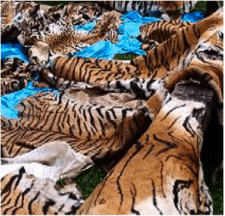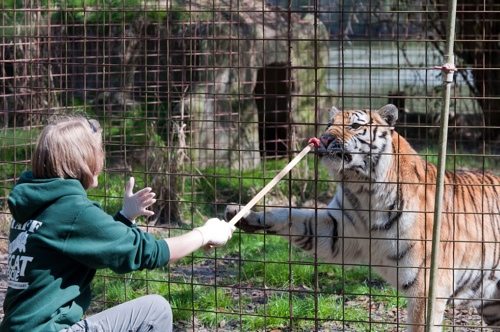Cruel world of the tiger trade
Cruel world of the tiger trade
By KATE JACKSON
Published: 24 May 2010

IN A dingy market stall in southern Tibet, a trader empties out a sack full of bones.
These pitiful relics were once a magnificent tiger, roaming wild and free.
Now sold on the black market to be used in medicines and Tiger wine, these bones can fetch around £600 per kilo
It’s a sickening sight.
At the turn of the twentieth century, there were estimated to be over 100,000 tigers in the wild. Now that figure has dwindled to approximately 3,500.
Despite efforts to protect the species, the demand for tiger bones, teeth and hide means poaching still continues. This, together with the decimation of their habitats and loss of natural prey due to hunting, has put tigers on the endangered list.
Scottish Debbie Banks, 38, travels the world hunting out illegal traders who profit from the sale of tiger products.
As head of the tiger campaign at the London-based Environmental Investigations Agency, Debbie compiles information about these salesman and how the tigers are taken from their native land to the shops.
With seven years experience at EIA, Debbie admits she never fails to be saddened by the plight of the tiger.
She says: “In 2005, I went to the traditional horse festivals in Tibet with a colleague.
“We thought we might see half a dozen people wearing animal skins.
“But there were literally hundreds of people wearing tiger, leopard and otter skins, some with the animal heads on.
“It was quite chilling.
“I realised then that I had seen more dead tigers and leopards than I would ever see alive.
“It still saddens me. But what drives me on is knowing that something can be done to increase wild tiger populations. They can recover very well if they are given enough forest and prey species. We have seen the trend reversed in parts of India, Russia and the Far East.”
In a hard-hitting documentary, Inside The Tiger Trade, on Nat Geo Wild tonight (mon 24th) at 10pm (*must keeP), we see Debbie travel back to the Tibet, to the horse festival at Nagchu.
Despite the Dalai Lama proclaiming in 2006 that wearing animal skins was wrong, prompting mass burning of furs, there has been a resurgence in the trend.
Debbie admits she was physically sickened to see so much animal hide on the Tibetans costumes, or Chupas.
To get the information she needed as to where these skins were coming from, she acted as an enthusiastic tourist who was fascinated by the outfits.
She says: “I found it really uncomfortable surrounded by people wearing real leopard and tiger and I had to pretend I was excited about what they were wearing.
“All the time, inside I was squirming and wanting to get out.”
It was in Lhasa, in Tibet, where she witnessed the horrific sight of a near-complete tiger skeleton being emptied out of a bag. There, the seller boasts of having two to three more complete sets.
And elsewhere in Tibet, she and her team of undercover investigators equipped with hidden cameras and microphones, found tailors who took orders from Chinese and Tibetan buyers for leopard and tiger skin.
Debbie says wearing endangered animals is a sign of wealth.
She says: “The traders were saying that if someone works in government, they are compelled to wear animal skin as a sign of prestige.
“It’s very troubling that people would be wearing this who don’t want to wear it.
“The prestige of wearing skin goes back hundreds of years in Tibet, to when the military were given a strip of fur if they had proved themselves in war. It was similar to us giving medals.
“Now that has expanded to people wearing animal skins for the prestige. It’s also expanded into home decor.
“We’re told a mixture of people are involved from Chinese businessmen and officials, and there are claims that an increasing number of Chinese military are buying tiger, leopard and snow leopard skins. It’s a luxury market.”
Traders claim big cat skins are sourced from India where there is the largest wild population – but even that is thought to be just around 1,400.
The tigers or their parts are trafficked into Nepal via porters who carry the bones during an arduous trek across the mountain passes.
They are then taken into China, defying the ban on the tiger bone trade which came into force in 1993.
Traders no longer used vehicles to pass through the borders anymore because of the fear of arrest.
Traditionally, tiger bone was used in medicines, particularly for arthritis and rheumatism. Even though it is no longer used in the manufacture of medicines, there is still demand for skin and bones.
In Xining, central China, Debbie discovered a shop in a tourist market where tiger teeth were on display for £700 (£480) each.
The trader admitted: “It’s more expensive than ivory.”
He also says he can source tiger bones, but demands a deposit of $400 (£280) just to see the products.
For Debbie and their team, paying money to a tiger bone trader is an ethical line they are not willing to cross.
In one frightening incident, an EIA investigator accepted a lift from a trader, who then drove him to an mystery location and up six flights of stairs in total darkness to see a skin for sale at $20,000 (£14,000)
Meanwhile Debbie, who doesn’t go undercover but provides back-up surveillance, was left helpless, not knowing where her investigator had been taken.
Debbie says: “It is a dangerous job.
“Years ago, I was able to speak to traders and they wouldn’t wonder why a tourist was asking questions about their tiger products.
“Now they are more suspicious and that’s why we use Chinese-speaking investigators.
“In this case, we didn’t know where the investigator had gone. He was having to pretend he’s an interested buyer so he couldn’t get on his mobile to tell us where he is.
“When the operatives come back from any surveillance, there’s that immediate relief that everyone’s made it out safe and sound.”
As EIA is a non-governmental organisation, it has no enforcement powers. Any information it uncovers is therefore passed onto the authorities, including CITES, the Convention on International Trade in Endangered Species, and the global police force, Interpol.
The trade doesn’t just exist overseas though.
In March, in London, a full sized stuffed tiger was confiscated by the Metropolitan police who believed it was being touted for an illegal sale.
Officers from the Wildlife Crime Unit arrested a 47-year-old man during the operation involving a tiger which had previously been used in a photoshoot by the late fashion designer Alexander McQueen.
Following his interview, the man was bailed until June 1.
Detective Constable David Flint, of the Wildlife Crime Unit says: “This was an obvious example with a tiger product being sold, we believe, illegally.
“It’s not common to find these sort of things but it does happen from time to time.
“This particular tiger was being sold for £50,000.
“You have to think about how this impacts on the world population of tigers. If you create a demand for such products in the western market, then sooner or later someone has to supply that demand and that’s where poaching comes in.”
Since the launch of Operation Charm in 1995 – the name used for police operation against the illegal trade in endangered species – the Metropolitan Police has seized more than 30,000 endangered species from sale in London.
These include traditional Chinese medicines, elephant ivory, animal skins and so-called fashion items like the 1960s style tiger skin coat seen in our pictures.
In this year, the Chinese Year of the Tiger, all hopes for the future of the tiger rests with a summit of world leaders led by Russian Prime Minister Vladimir Putin in September.
And now, with a new government in place, Debbie says she hopes Prime Minister David Cameron will push for moves to protect the majestic cats.
She says: “It would be very encourageing for us if David Cameron or Deputy Prime Minister Nick Clegg were present at that summit.
“It would be a real indication that our leaders are uniting on this.
“If we can save the tiger, you’re not only saving the species but the forests they live in and the ecosystems that many other species rely on.”
What are tiger’s sold for?
Tigers are prized as powerful status symbols and used in medicine. Here is what is tigers are sold for:
Skin: Small pieces of tiger skin are used to protect the owner from black magic. The most expensive part is the forehead as the stripes resember the Chinese character for royalty and are believed to bring the owner luck.
Teeth: Used for jewellery and believed to bring luck and protection.
Claws: Often inlayed in gold to make pendants.
Whiskers: Believed to have magical powers.
Tail: Kept as a trophy to protect against curses.
Penis: Traditional tonic with aphrodisiac powers.
Flesh: Cooked and eaten to treat skin diseases.
Fat: Bottled and used to protect farms from damage from wild pigs.
Bone: Ground into powder and used to treat rheumatism and headaches, or dipped into rice wine.
[/vc_column_text][/vc_column][/vc_row]




